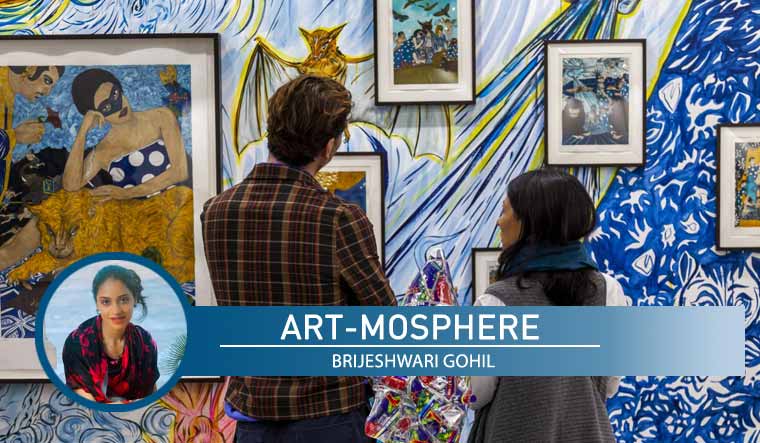A decade ago, I worked on an exhibition on the artist Raja Ravi Varma. He remains a national treasure, one of the most popular Indian artists who continues to be celebrated, with his 18th and 19th Century depiction of mythology, royalty and gentry reaching record prices. As I read about his work, the royalty and the aristocrats he painted, it dawned on me (then as typical fresh-out-of-college youngster), that artists such as Raja Ravi Varma only survived and flourished due to their patronage.
The success of artists has, for time immemorial, been dependent upon their patrons. Would the strains of Miyan Tansen’s raagas have mesmerised the sensibilities without Akbar’s patronage? Or would Michelangelo and Leonardo Da Vinci have been able to enrich the renaissance if it were not for the Medicis? The impoverished life of Vincent Van Gogh is a sad testament to the necessity of a generous connoisseur.
The theme of the 2019 Venice Biennale, ‘May we live in interesting times’, resonates here. For we certainly do live in exceptionally exciting times. The once elite, closed circle for the arts is gradually opening its doors for a larger audience and I could not be more ecstatic about it. For why must the brilliance of art not be democratised?
Democratisation in the arts means having equality, freedom, access and the right to create and consume art.
As the world is opening up, slowly but surely so is the way art is viewed and valued. I still remember trying to narrow in on a date to open an exhibition on India’s first Oscar winner, Bhanu Athaiya, last October and thinking to myself that the art calendar was just as busy, if not busier, than the big fat Indian wedding calendar in India during the winter months.
The burgeoning art festivals and events that have taken over the calendar and offer myriad experiences and are open to all.
Mumbai, for example, witnessed the first Mumbai Art Week, with displays by galleries and art houses in the large, sprawling grounds of Mahalakshmi. Walking past each of these stalls, seeing beautiful works of art, each unique in its own right, I could only think of how experiencing art and engaging with artists have transformed over the years. Gone are the days where dusty, sprawling, boring museums with no engagement or interaction were the only places to see art collections. The recently concluded India Art Fair in New Delhi has been providing artists, collectors and consumers the opportunity to meet and engage with like-minded individuals from all across the globe, facilitating the growth of a cultural ecosystem.
We now also have private collectors in India, the ever expanding tribe of new-age patrons, taking a big step and opening their treasures to the public. Be it a Museum of Art and Photography (MAP) in Bengaluru, the Kiran Nadar Museum of Art in Delhi, the Piramal Museum of Art in Mumbai and, of course, the most newly minted, Nita Mukesh Ambani Cultural Centre (NMACC).
It almost reminds me of the way many erstwhile royal families of India opened their palaces as heritage destinations following Independence. Beauty, creativity and art ought to be enjoyed by everyone.
I do feel that it is this diversity of places and the accessibility they provide which form the foundation of democratisation in the arts. Looking at works by young contemporary artists on display is sure to inspire the school-going art student or the Fine Arts hopeful to opt for a career in the arts or simply be inspired and encouraged to trudge along.
On the other hand, public art programmes such as the Kala Ghoda Festival in Mumbai are a perfect example of making art accessible to the community and a larger audience. The festival is also perhaps one of the first of its kind in the country, having started in 1999. The sheer delight and fascination on children's faces when shown the sculptures displayed around Kala Ghoda or the heritage walks as part of the festivals that shed light on art, architecture and design, weaving in historic stories of the community, are proof enough of “interesting times”. Would this not be educating a future town planner and urban developer, helping them have a sense of identity and community?
Similar to this is the Serendipity Arts Festival in Goa. I was yet again thrilled to witness the transformation of 12 heritage locations, juxtaposed with contemporary art installations. Each space was a medium of expression, sparkling conversation amongst visitors on sustainability, climate change, cultural norms, local crafts and so much more. Freedom of expression is an integral aspect of what democracy stands for and the best example of art without borders is the digital medium.
Viewing art as well as creating a marketplace for it could not have been fathomable a decade ago. Nor would one perhaps be aware of the many art happenings if it were not for social media.
The possibilities of the digital, the growing number of private museums, art weekends, public art programmes, art fairs, act as a stepping stone in challenging the way art is created, presented and purchased.
Brijeshwari Gohil is a curator and conservator with a Masters in Heritage Management and Conservation from the UK. She is currently pursuing her PhD.


